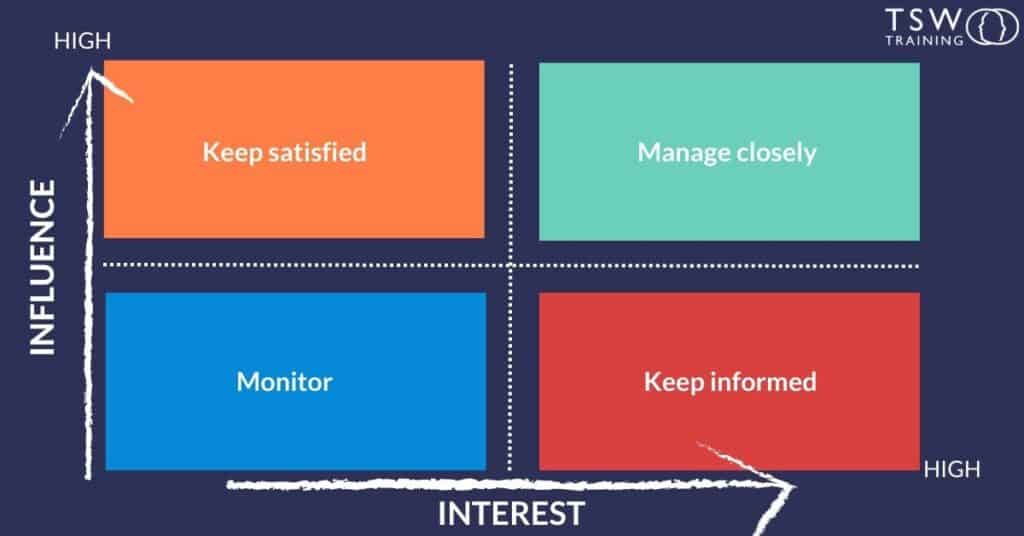When embarking on a new project, a stakeholder analysis matrix can be an incredibly useful tool in establishing support from all those involved.
The project could comprise starting a new business, launching a project internally within your company, or organising an activity or event – but the principles remain the same.
Here we’ll look at the steps involved in conducting a stakeholder analysis matrix, and provide some tips, examples and pointers to help it go smoothly.
Key points:
- Stakeholder analysis involves identifying all parties involved in your project, whether that’s an interest in it, an influence upon it, or both. By engaging them positively, you can help to build relationships, identify issues and make smarter decisions.
- The steps you take in the analysis involve first identifying all potential stakeholders; categorising and prioritising them according to their interest or influence; working out their needs, concerns and expectations; developing a plan to engage with them, and monitoring this engagement.
- To ensure the effectiveness of your stakeholder analysis, you should be as thorough as possible, engage your stakeholders at all steps, use multiple means to collect information, and be prepared to be flexible in case things change.
What is stakeholder analysis and why is it important?
Stakeholder analysis essentially involves identifying and assessing the interests, concerns and influence of individuals or groups that have an impact on the project, or are impacted by it.
By identifying key stakeholders and their needs and expectations, you can help the decision-making process, build positive relationships and mitigate risks. This should ultimately help the project to be a success.
What are the steps in conducting a stakeholder analysis matrix?
Step 1: Identify your stakeholders
The first step in conducting your analysis is to identify all potential stakeholders. So this includes any individuals or groups who have an interest in the project. Likewise, you should identify those who have a direct – or possibly indirect – impact on it.
Depending on the project or activity, the range of potential stakeholders could be broad. It might include customers (both current and future), suppliers, staff, shareholders, industry regulators, government bodies, community groups and so on.
💡Expert Tip💡
To ensure that you identify everyone involved, you might find it helpful to brainstorm a list of all potential stakeholders, and then categorise them based on their level of influence and interest in the project.
Step 2: Categorise your stakeholders in the Stakeholder Analysis Matrix
Once all potential stakeholders have been identified, the next step is to categorise them. Ultimately, this will help you to know how you should engage with them, and who to prioritise.
If you’ve brainstormed in the first step, you may already have an idea of each stakeholder’s level of influence and interest in the project. You can formalise this by creating a stakeholder analysis matrix (also known as a stakeholder map), which is a useful visual template to help classify your stakeholders, and work out how to manage them accordingly.
To create a stakeholder analysis matrix: draw a grid with four quadrants. Label these according to the stakeholder’s level of interest and influence.
So the top-left quadrant, for example, will represent stakeholders who have a high level of influence, but may not have a large amount of interest in the project. The bottom-right quadrant, on the other hand, represents those who are very interested in the project, but may not exert a huge amount of influence.
Next, place each stakeholder in the appropriate quadrant. Stakeholders who have high levels of influence and interest should be given the most attention and priority, while stakeholders who have low levels of influence and interest can be given less priority.
⏰Key Point: Stakeholders’ position within the matrix indicates the actions you should take with them:
- Top-right – manage closely: Fully engage with the most interested, most influential stakeholders, making the greatest efforts to keep them sweet.
- Top-left – keep satisfied: You should put the work in with these stakeholders so they’re kept satisfied. However, as they’re less interested, it’s best not to bombard them with regular updates.
- Bottom-right – keep informed: You should keep these stakeholders informed, talking to them regularly. This group may be able to help with the project detail, and can give early warnings of issues arising.
- Bottom-left – monitor: It’s always best to know where you stand with any stakeholders, but there’s no need to involve the least interested, least influential group with regular updates.
Step 3: Understand stakeholder needs, concerns and expectations
Once stakeholders have been identified and categorised, the next step is to understand their needs, concerns and expectations. If you have existing information or feedback – from previous projects, for instance – you’re off to a good start. If you don’t have enough to go on, you can ascertain what you need to know by conducting interviews, surveys or focus groups with stakeholders.
During this step, it’s important to listen to stakeholders and try to understand their perspectives. This can help to identify potential risks or issues that may arise. It can also guide your decision-making to ensure that stakeholders’ needs and concerns are addressed.
It’s important to get this right, because it can mean the difference between winning stakeholders’ support – possibly benefitting from their collaboration and expertise – and causing them to object to the project, and maybe even obstructing it.
Step 4: Develop, apply and monitor a stakeholder engagement plan
Based on your analysis, the fourth step is to develop a stakeholder engagement plan. This should outline how stakeholders will be engaged throughout the project or activity, how their needs and concerns will be addressed, and how their expectations will be managed.
This plan should also identify the methods and channels you’ll use to communicate with stakeholders. It’s also useful to work out how often they’ll be updated, and who’s responsible for communicating with them.
Finally, you should monitor and evaluate engagement throughout the project or activity. You can do this by tracking stakeholder feedback, and keeping an eye on their levels of engagement. You may have to adjust the engagement plan as required – such as if certain stakeholders feel they’re not receiving enough updates.
⏰Key Point: The monitoring and evaluating process can help to ensure that stakeholder needs and concerns are being addressed. Plus it can also help to identify potential issues or risks that may arise.
How can I improve my stakeholder analysis?
Here are some useful tips and pointers to make sure your stakeholder analysis is as smooth and effective as possible.
#1. Be as thorough as you can
Take the time to identify and analyse all potential stakeholders, even if they may not appear to have a significant impact on your project. This can help to ensure that all potential risks are identified and addressed.
#2. Involve your stakeholders
It may sound obvious, but engaging with stakeholders throughout the analysis should help them to feel that they’re part of the process. Involving them in every step can help build positive relationships, increasing their buy-in and support for the project.
#3. Use multiple methods to collect information
Use a variety of methods to gather information from stakeholders, including interviews, surveys, focus groups and so on. And be sure to analyse any measurable data you collect. This can help to ensure that stakeholder perspectives are fully understood.
#4. Flexibility is your friend
Stakeholder needs and concerns may change over time, so it’s important to be flexible and adapt the stakeholder engagement plan as required. Regularly monitor and evaluate engagement to make sure that stakeholders are satisfied, with their needs being addressed.
What are the advantages of a successful stakeholder analysis?
Conducting and applying a successful stakeholder analysis can have a wide range of benefits. For example, when launching a project internally within a company, getting all stakeholders involved should help with their motivation, and ultimately productivity.
It can also contribute to individuals’ wellbeing, and overall morale, as stakeholders will feel valued in the process. As such, not only will they be contributing to the project’s success, but all stakeholders will feel a benefit – no matter how small.
Are you about to embark on a project in your company? Find out more about courses for developing core skills for project managers here.








